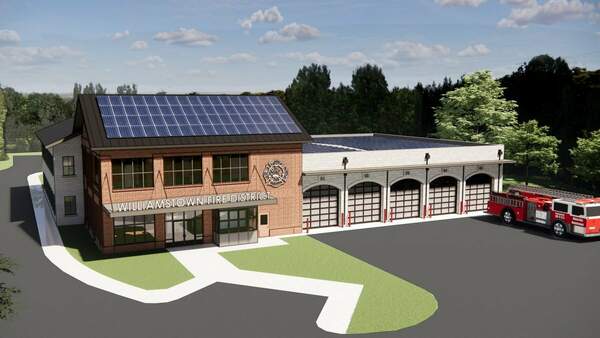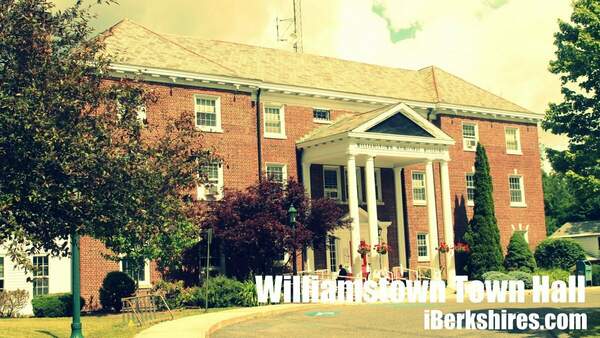Williamstown Con Comm Frames Questions on Lowry, Burbank
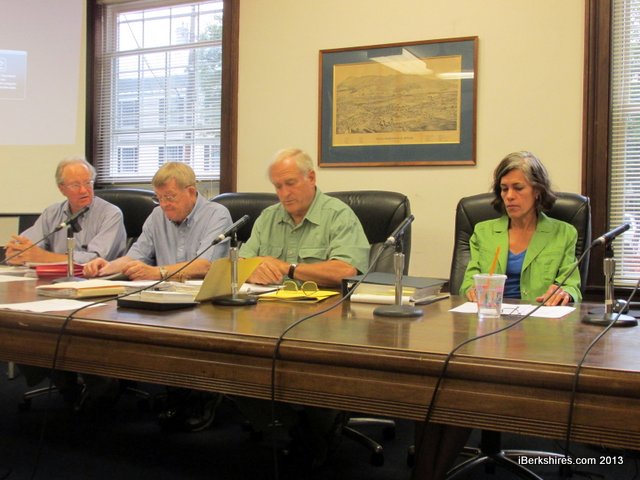 The Conservation Commission has four questions for the Selectmen on lands being eyed for affordable housing. The Conservation Commission has four questions for the Selectmen on lands being eyed for affordable housing. |
Updated on Aug. 11, 2013, at 6:13 p.m., with the four questions being directed to the Selectmen and further information.
WILLIAMSTOWN, Mass. — The Conservation Commission on Thursday voted to send a list of four questions to the Board of Selectmen that the commission wants answered before it decides whether to release all or parts of two town-owned parcels for the purpose of building affordable housing.
The list of questions was narrowed down from a larger slate of 13 submitted by individual board members to Chairman Philip McKnight.
The original list included a number of questions related to the issue of affordable housing that some commissioners felt were not pertinent to the panel's charge.
"I think only four of the questions are really germane to the Conservation Commission," Commissioner Hank Art said. "I think 1 through 7 and 13 don't deal with the purview of the Conservation Commission at all but deal with the mechanics of affordable housing and its financing.
"I think they would delay the process and really are questions that the Affordable Housing Committee and Affordable Housing Trust and other town committees are dealing with and have nothing to do with conservation land."
Art later emphasized that he believed the other questions are important for the town to address, but he felt the Con Comm was not the appropriate place for those questions to be aired. He suggested the commission forward the questions to the ad hoc Spruces Roof Group (formerly the Long-term Coordinating Committee), on which he also serves.
The specific questions are (with numbering from the original list):
8. Should the Town acquire the lands owned by Morgan Management situated along the Hoosic River [the Spruces Mobile Home Park site], would those lands (or a portion thereof) be included in a Town Meeting warrant article transferring them to the care, custody, management and control of the Conservation Commission? If so, how much of the Spruces would be set aside as conservation land
9. Set forth your argument as to how Lowry/Burbank are conservation lands no longer needed by the Town for such purposes under the specific terms of the Conservation Commission Act, G.L.-40, Sec. 8C.
10. Though some evaluation of the suitability of Lowry as a site for affordable housing has been accomplished, such is not the case for Burbank. The Conservation Commission requires a thorough analysis of both sites that clearly documents that either, or both, of the properties, or just a portion of either, are suitable for the proposed purpose.
12. The Conservation Commission must address a statutory requirement that no other alternative sites to the requested conservation properties are available for the proposed affordable housing projects. Since the Affordable Housing Trust is permitted to purchase private land, the Commission requests the Trust describe its efforts to evaluate and purchase possible sites in Williamstown, given the probable availability of FEMA grant money to assist in that process. Has a review been undertaken and completed? If so, what is the outcome? if not, when will such an evaluation be completed?"
All the questions can be found
here.
Art was joined by Commissioners Van Ellet and Richard Schlesinger in voting to narrow the scope of the questions. That was enough to block the more expansive questions on a 3-3 vote (Commissioner Thomas Ennis has recused himself from discussions relating to the Selectmen's requests).
Commissioner Sarah Gardner advocated for Con Comm pressing the Selectmen on a variety of issues related to its requests to remove some or all of the Lowry and Burbank properties from the commission's care, custody management and control.
"On [Question] No. 4 ... 'what type of housing does the [Board of Selectmen] envision?' ... to me it's important because most affordable housing developments in the state are only 20 percent affordable," Gardner said. "I think it is germane to our decision. If it's going to be 20 percent affordable, I think it does affect our decision.
"We might feel really differently if we take this land out [of conservation] and it ends up being 30 percent market-rate units and a couple affordable."
Gardner's assertion that the Con Comm should consider the quality of the development appeared at odds with a statement she made earlier in the meeting.
"I do feel like it's important to remember our mandate as the Conservation Commission is to evaluate whether it's surplus land ... and it's the Affordable Housing Committee's mandate to develop affordable housing," Gardner said. "It always makes me uncomfortable when the public asks us to comment on affordable housing and where it should be.
"Whether this land is being taken out [of conservation] for a shopping center or a nursing home or a school, that shouldn't affect our decision, legally.
"I just reread our Conservation Commission Handbook ... and drives that point home that we have a specific mandate."
McKnight joined Gardner in the voting and also argued for the wider scope of questions. He cited proposed questions like that asking whether the town could legally give priority to former residents of the Spruces Mobile Home Park in a proposed development as critical to determining whether land should be replaced to meet the needs of those residents.
"Is it lawful under state and federal law for the Board of Selectmen to provide that a specific class of individuals, namely, the current and former residents of the Spruces who were resident of the property at the time of the Irene storm in August 2011, be placed in a class which permits them, and only them, to have first access to homes built on conservation land in derogation of the rights of all those who would otherwise be eligible for such affordable housing under state and federal law," read the first question in the draft of 13 queries considered by the commission.
"If it isn't [legal], they shouldn't be asking for conservation land," McKnight said.
After the panel approved the narrower slate of four questions, McKnight noted that this was the first of perhaps several rounds of questions that the commission will pass along to the Selectmen. The Con Comm hopes to receive the first round of answers at its Sept. 12 meeting.
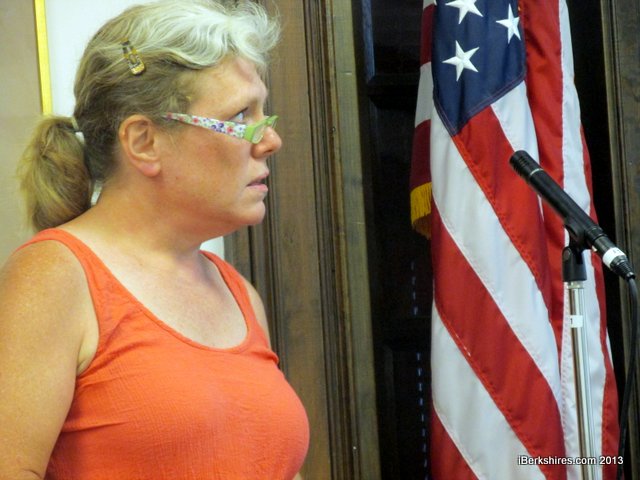 |
|
Above, Agricultural Chairwoman Beth Phelps gave a presentation on the importance of farmland; the Rev. Peter Elvin said Spruces residents shouldn't be expected to move to another floodplain. |
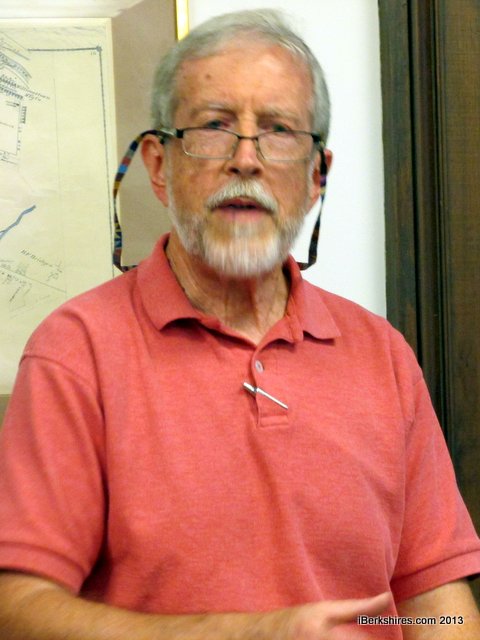 |
Lowry and Burbank once again dominated the Con Comm's meeting. Gardner and Art each shared with the commission the latest on their efforts to seek clarity and guidance from officials in Boston about the proper procedure to use in addressing the properties. Residents provided verbal and written testimony both for and against releasing the land.
The chairman of the town's Agricultural Commission delivered a slide show to help drive home the point that both Lowry and Burbank are necessary to the agriculture and the town's economy.
Beth Phelps noted that businesses such as Gala and Mezze restaurants, the Williams Inn and Wild Oats Market all tout the sale of locally produced food, including beef fed by hay raised on the Lowry property.
Phelps further noted that a number of state policies are in place to support the preservation of agricultural land, including a 1981 executive order by then-Gov. Edward King that reads, in part, "State funds and federal grants administered by the state shall not be used to encourage the conversion of agricultural land to other uses when feasible aternatives are available."
Phelps was followed at the podium by a number of the residents who frequently speak at committee meetings against using Lowry and/or Burbank for affordable housing, but a couple of new voices were added to the mix on Thursday night.
Stuart Freyer of Northwest Hill Road laid out an argument why he believes a proposed development of the Lowry property would be unfundable.
He was supported by Suzanne Kemple, who testified as she has previously that Massachusetts requires affordable housing projects "adhere to the 10 sustainable growth principles," which emphasize, among other things, preserving natural resources and agriculture.
The Rev. Peter Elvin, one of the founders of the nonprofit group Higher Ground, argued that the town-owned sites under consideration for affordable housing development — the former town garage site on Water Street and the former PhoTech mill property on Cole Avenue — are ill-suited to serve the population displaced from the Spruces by Tropical Storm Irene in 2011.
"I can't imagine relocating Spruces residents to any property in town that is in a floodplain or floods for any other reason," Elvin said, noting that at least some of the PhoTech site is in the 100-year floodplain. "I don't grasp the compassion or the justice or the intelligence."
In other business on Thursday, the Con Comm OK'd two projects: a bridge in Williams College's Hopkins Forest that will allow the college to reopen a trail damaged by spring flooding and the installation of a "dry hydrant" at the Five Corners intersection by the Williamstown Fire District.
Tags: affordable housing, conservation commission, farmland, lowry property, Spruces,
 The Conservation Commission has four questions for the Selectmen on lands being eyed for affordable housing.
The Conservation Commission has four questions for the Selectmen on lands being eyed for affordable housing.


 WILLIAMSTOWN, Mass. — The Prudential Committee on Wednesday signed off on more than $1 million in cost cutting measures for the planned Main Street fire station.
WILLIAMSTOWN, Mass. — The Prudential Committee on Wednesday signed off on more than $1 million in cost cutting measures for the planned Main Street fire station.